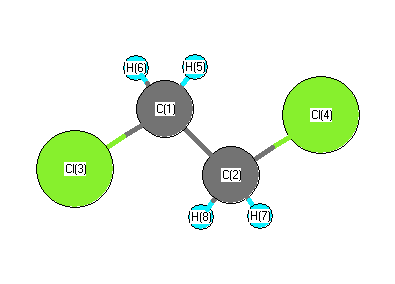Jump to
S1C2
Vibrational Frequencies calculated at QCISD(T)/TZVP
Geometric Data calculated at QCISD(T)/TZVP
Electronic energy levels
Charges, Dipole, Quadrupole and Polarizability
Jump to
S1C1
Energy calculated at QCISD(T)/TZVP
| | hartrees |
|---|
| Energy at 0K | -997.749077 |
| Energy at 298.15K | -997.753949 |
| HF Energy | -997.103428 |
| Nuclear repulsion energy | 201.195216 |
The energy at 298.15K was derived from the energy at 0K
and an integrated heat capacity that used the calculated vibrational frequencies.
Vibrational Frequencies calculated at QCISD(T)/TZVP
| Mode Number |
Symmetry |
Frequency
(cm-1) |
Scaled Frequency
(cm-1) |
IR Intensities
(km mol-1) |
Raman Act
(Å4/u) |
Dep P |
Dep U |
|---|
| 1 |
A |
3167 |
3051 |
|
|
|
|
| 2 |
A |
3107 |
2993 |
|
|
|
|
| 3 |
A |
1485 |
1430 |
|
|
|
|
| 4 |
A |
1383 |
1332 |
|
|
|
|
| 5 |
A |
1244 |
1198 |
|
|
|
|
| 6 |
A |
1072 |
1032 |
|
|
|
|
| 7 |
A |
976 |
940 |
|
|
|
|
| 8 |
A |
675 |
651 |
|
|
|
|
| 9 |
A |
270 |
260 |
|
|
|
|
| 10 |
A |
122 |
117 |
|
|
|
|
| 11 |
B |
3179 |
3062 |
|
|
|
|
| 12 |
B |
3098 |
2984 |
|
|
|
|
| 13 |
B |
1478 |
1424 |
|
|
|
|
| 14 |
B |
1360 |
1310 |
|
|
|
|
| 15 |
B |
1179 |
1136 |
|
|
|
|
| 16 |
B |
913 |
880 |
|
|
|
|
| 17 |
B |
701 |
675 |
|
|
|
|
| 18 |
B |
415 |
399 |
|
|
|
|
Unscaled Zero Point Vibrational Energy (zpe) 12912.3 cm
-1
Scaled (by 0.9632) Zero Point Vibrational Energy (zpe) 12437.1 cm
-1
See section
III.C.1 List or set vibrational scaling factors
to change the scale factors used here.
See section
III.C.2
Calculate a vibrational scaling factor for a given set of molecules
to determine the least squares best scaling factor.
Geometric Data calculated at QCISD(T)/TZVP
Point Group is C2
Cartesians (Å)
| Atom |
x (Å) |
y (Å) |
z (Å) |
|---|
| C1 |
0.299 |
0.695 |
0.899 |
| C2 |
-0.299 |
-0.695 |
0.899 |
| Cl3 |
-0.299 |
1.699 |
-0.473 |
| Cl4 |
0.299 |
-1.699 |
-0.473 |
| H5 |
0.007 |
1.206 |
1.818 |
| H6 |
1.384 |
0.655 |
0.827 |
| H7 |
-0.007 |
-1.206 |
1.818 |
| H8 |
-1.384 |
-0.655 |
0.827 |
Atom - Atom Distances (Å)
| |
C1 |
C2 |
Cl3 |
Cl4 |
H5 |
H6 |
H7 |
H8 |
| C1 | | 1.5131 | 1.8020 | 2.7593 | 1.0907 | 1.0885 | 2.1333 | 2.1588 |
C2 | 1.5131 | | 2.7593 | 1.8020 | 2.1333 | 2.1588 | 1.0907 | 1.0885 | Cl3 | 1.8020 | 2.7593 | | 3.4494 | 2.3630 | 2.3687 | 3.7108 | 2.9000 | Cl4 | 2.7593 | 1.8020 | 3.4494 | | 3.7108 | 2.9000 | 2.3630 | 2.3687 | H5 | 1.0907 | 2.1333 | 2.3630 | 3.7108 | | 1.7836 | 2.4120 | 2.5258 | H6 | 1.0885 | 2.1588 | 2.3687 | 2.9000 | 1.7836 | | 2.5258 | 3.0627 | H7 | 2.1333 | 1.0907 | 3.7108 | 2.3630 | 2.4120 | 2.5258 | | 1.7836 | H8 | 2.1588 | 1.0885 | 2.9000 | 2.3687 | 2.5258 | 3.0627 | 1.7836 | |
 More geometry information
More geometry information
Calculated Bond Angles
| atom1 |
atom2 |
atom3 |
angle |
|
atom1 |
atom2 |
atom3 |
angle |
| C1 |
C2 |
Cl4 |
112.383 |
|
C1 |
C2 |
H7 |
108.947 |
| C1 |
C2 |
H8 |
111.103 |
|
C2 |
C1 |
Cl3 |
112.383 |
| C2 |
C1 |
H5 |
108.947 |
|
C2 |
C1 |
H6 |
111.103 |
| Cl3 |
C1 |
H5 |
106.962 |
|
Cl3 |
C1 |
H6 |
107.486 |
| Cl4 |
C2 |
H7 |
106.962 |
|
Cl4 |
C2 |
H8 |
107.486 |
| H5 |
C1 |
H6 |
109.858 |
|
H7 |
C2 |
H8 |
109.858 |
Electronic energy levels
Charges, Dipole, Quadrupole and Polarizability
